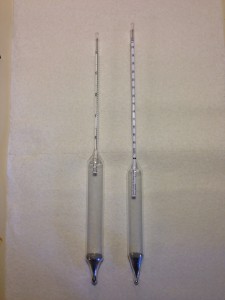[I’m back! You may have noticed a dearth of posts recently. I was finishing up work on my first book and was putting in a lot of late nights as the deadline approached. But, now I’m done and I have a slew of stuff coming to BWJ soon. — Chris ]
As an all-grain brew day comes to an end, a brewer hopes that he or she will yield a reasonable volume of beer at a reasonable original gravity (OG). In the best case scenario, the brewer hits both the target batch volume and target OG on the nose to within the precision of his instruments. In a less than optimal — but certainly not catastrophic — scenario, one or the other elements is slightly off, but not by much.
Hitting both your target volume and OG requires some planning up front. Primarily, you need to know your extract efficiency. You’ll need to understand how much grain to mash and how much water you’ll need to mash, sparge, and collect the wort. However, even for the most experienced brewer, the best plans can sometimes go awry. In this series of articles, I want to outline ways to hit your target original gravity when something has gone amiss on brewday.
Predicting OG
You can wait until your wort is in your fermenter to check the OG, but at that point if something is off, it is too late to do anything about it. Luckily, there is an easy way to estimate your post-boil specific gravity based on the volume and specific gravity of your pre-boil wort. Estimating your post-boil specific gravity early in the boil gives you the length of the boil to make any changes.
Your kettle should be calibrated, either with a sight glass or a dip stick. When you have your pre-boil wort collected, measure the volume just before it comes to a boil. Then, take a refractometer (or hydrometer) reading of the specific gravity. You can then use the equation C1V1= C2V2 to estimate your post-boil specific gravity.
In the equation, the two “C”s stand for concentration and the “V”s stand for volume. More specifically, the “C”s stand for the concentration of whatever is dissolved in the liquid — the concentration of the solute, in chemistry terms. In wort, sugar is the solute and water is the solvent. This equation shows that the concentration of the solute is inversely proportional to the volume of the mixture. For example, if you add volume to a sugar solution (by adding water), the sugar concentration goes down. If you remove water (by evaporation), the sugar concentration goes up.
In our case, the brewer can take the pre-boil volume and gravity as C1 and V1, and use it to predict either C2 or V2. For example, let’s say you have a 5.0-gallon (19-L) batch of beer planned. (And let’s further say we’ll work this problem using English units, just to avoid the clutter of two numbers for each measurement. The equation works in the exact same way using metric units.) You collect 6.5 gallons of wort at OG 1.043 and plan to boil it down to 5.0 gallons. What will your OG be? Substituting the values into the equation, using “gravity points” to express the specific gravity, we get:
43(6.5) = X(5.0)
Solving for X yields:
279.5 = 5X
55.9 = X
Therefore, the estimated specific gravity is 55.9 “gravity” points, or 1.0559. In brewing, specific gravity is almost always expressed as four digits, so this rounds to 1.056.
Assumptions
There are two things you should note about using this equation to predict your OG. The final OG measurement is usually taken from cool wort in the fermenter. In this example, we’ve estimated the post-boil specific gravity. However, the chilled wort volume will be slightly smaller than the post-boil volume as wort contracts slightly when it cools. As such, the specific gravity of your wort will rise slightly on cooling. (The density of water near boiling is about 0.96 of what it is near 50 °F/10 °C.)
Another variable that can affect this equation is molecules that contribute to the pre-boil specific gravity, but not the post-boil specific gravity. Specifically, some proteins will coagulate during the boil and change from being soluble (and therefore contributing to specific gravity) to insoluble (and not). As such, post-boil volume will be slightly overestimated using this equation. However, as the protein concentration is far lower than the sugar concentration in wort, this does not amount to much.
These two factors don’t effect the outcome much, and are in opposition. You can just ignore both if you are happy with an estimate within 2 “gravity points.”
In the next installments, I will explain what corrective measures can be taken if you estimate your OG will be lower than expected or higher than expected.
—
Related Articles


Speak Your Mind